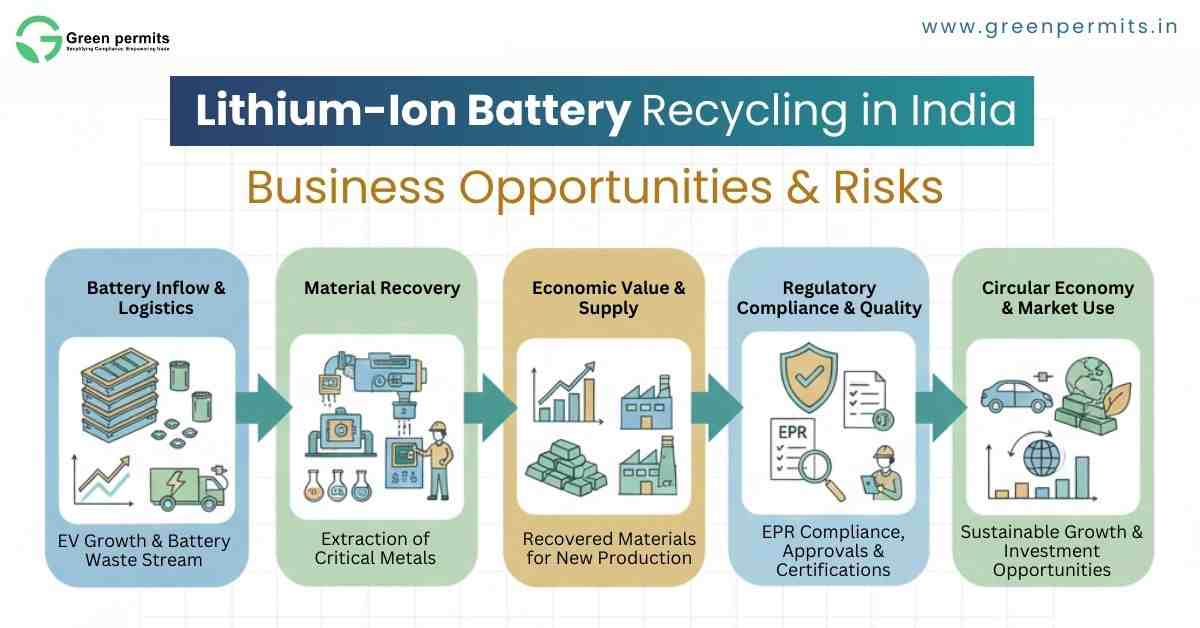Lithium-Ion Battery Recycling in India: A Business Shift in the Making
India’s move toward electric mobility is changing more than just how vehicles run. It is also creating an urgent need to manage used lithium-ion batteries in a safe and structured way. For businesses, this shift opens up a recycling opportunity that is driven not by trends, but by regulation and long-term demand.
As battery usage increases across EVs, electronics, and energy storage systems, recycling is becoming an essential part of the value chain rather than a side activity.
Opportunity Beyond Metal Recovery
At first glance, lithium-ion battery recycling appears to be about recovering valuable metals like lithium, cobalt, and nickel. In practice, the opportunity goes deeper. Recycling is now closely tied to compliance requirements under India’s battery waste regulations, which means producers actively look for registered recyclers to meet their obligations.
Businesses that understand this compliance-driven demand are able to build stable partnerships and predictable revenue streams, instead of depending only on fluctuating metal prices.
Related Article -
https://www.greenpermits.in/lithium-ion-battery-recycling-business-in-india-risks/
Why Compliance Planning Makes or Breaks the Business
Lithium-ion battery recycling is not a business where operations can begin first and approvals can be managed later. Fire safety, pollution control, hazardous waste handling, and registration requirements all play a central role.
Many early-stage recyclers face delays not because their technology is weak, but because compliance was treated as paperwork rather than infrastructure. Those who plan approvals early move faster, avoid operational stoppages, and gain long-term credibility with producers and OEMs.
If you are exploring lithium-ion battery recycling in India, understanding the regulatory landscape before investing can significantly reduce risk.
Connect with Green Permits for expert support on battery recycling approvals, EPR compliance, and regulatory planning.
+91 78350 06182 |
wecare@greenpermits.in
Lithium-Ion Battery Recycling in India: A Business Shift in the Making
India’s move toward electric mobility is changing more than just how vehicles run. It is also creating an urgent need to manage used lithium-ion batteries in a safe and structured way. For businesses, this shift opens up a recycling opportunity that is driven not by trends, but by regulation and long-term demand.
As battery usage increases across EVs, electronics, and energy storage systems, recycling is becoming an essential part of the value chain rather than a side activity.
Opportunity Beyond Metal Recovery
At first glance, lithium-ion battery recycling appears to be about recovering valuable metals like lithium, cobalt, and nickel. In practice, the opportunity goes deeper. Recycling is now closely tied to compliance requirements under India’s battery waste regulations, which means producers actively look for registered recyclers to meet their obligations.
Businesses that understand this compliance-driven demand are able to build stable partnerships and predictable revenue streams, instead of depending only on fluctuating metal prices.
Related Article - https://www.greenpermits.in/lithium-ion-battery-recycling-business-in-india-risks/
Why Compliance Planning Makes or Breaks the Business
Lithium-ion battery recycling is not a business where operations can begin first and approvals can be managed later. Fire safety, pollution control, hazardous waste handling, and registration requirements all play a central role.
Many early-stage recyclers face delays not because their technology is weak, but because compliance was treated as paperwork rather than infrastructure. Those who plan approvals early move faster, avoid operational stoppages, and gain long-term credibility with producers and OEMs.
If you are exploring lithium-ion battery recycling in India, understanding the regulatory landscape before investing can significantly reduce risk.
Connect with Green Permits for expert support on battery recycling approvals, EPR compliance, and regulatory planning.
📞 +91 78350 06182 | 📧 wecare@greenpermits.in













